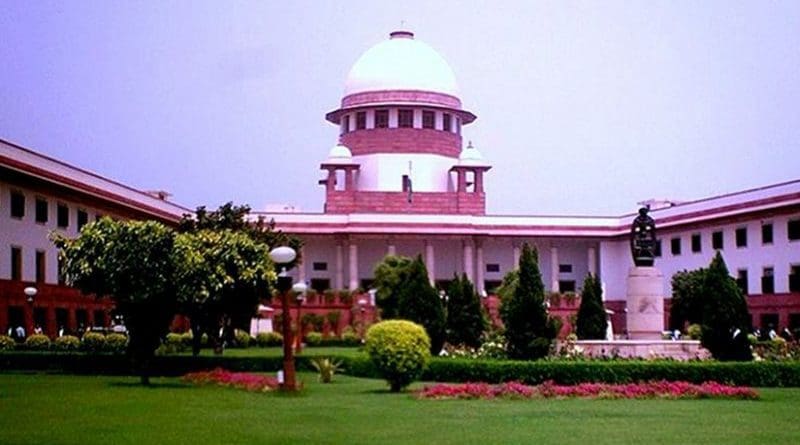Community Resources And Lessons From India’s Supreme Court – OpEd
By Prakhar Raghuvanshi and Chaaru Gupta *
With advancement in the legal jurisprudence and recognition of rights, community rights are also being accredited. Community rights are, in simple terms, set of powers of a community which aid in development of the community. These rights protect public parks, lay grounds, libraries, forests, lakes, ponds etc. It includes environmental rights, worker’s rights, rights of nature and democratic rights too. Many of these rights fall within the extended purview of Article 21 of the Constitution of India (Constitution) which grants right to life and personal liberty to every person in India. In this article, I aim to introduce how the Supreme Court of India (SCI) shields these rights.
The Beautiful journey
Article 21 is not the sole saviour of these rights. Article 48A of the Constitution imposes a duty on the state to protect and improve environment, which is interpreted by the SCI time and again whenever an opportunity arises. As early as in 1972, the SCI encountered a question whether communal rights were abolished by a municipal law (Estates Abolition Act, 1948) and such lands would stand transferred to the government. However, the court held that these rights were inalienable and even explicit destruction of all rights would not apply to community rights. Such recognition of rights is of utmost importance in the era of commercialization. Without such recognition, the development authorities would go on allotting community resources to private industries as urbanisation is reaching to rural towns too. Utilitarianism is the preferred stance, however welfare state is a better idea. If not, this would harm the community as well as the environment.
Yet again in 2001, SCI expounded upon community rights. They interpreted community rights being a part of right to environment. Community resources maintain ecological balance and hence need to protected for proper enjoyment of right to life enshrined under Article 21 of the Constitution. If the government authorities find the resource being in disuse and getting damaged, they should bestow their attention in developing the same for the benefit of the public at large rather than allocating it to private entities. If such resource is allocated for commercialization or any other purpose it is held to be against the rights of village commons.
Such recognition by the SCI seems important for two apparent reasons, viz, firstly any legislation which transferred lands to the state after independence cannot be presumed to transfer community resources to the state too. In my opinion, the government is a mere custodian of that land and at max can maintain the land/pond/forest, any other kind of interference would infringe upon the rights of village commons and is not permissible. Secondly, village common land is usually grabbed by unscrupulous persons using muscle power, money power, political affiliations. The ground reality is that there is not even an inch of land for community resources, though it may exist on paper. To save village commons from such atrocities, such interpretation of the law and constitution becomes necessary.
In 2011, the SCI held that community resources are in use by village commons since time immemorial for collective benefit of the community. There is a need to uphold the historical and traditional practices of rural India. Interestingly in this case, the court not only granted relief to the parties concerned but also directed the government to prepare schemes to make sure that such lands remain with the village commons. Any such resources transferred by the government is deemed to be illegal and shall be considered null and void.
The Failing National Green Tribunal
The National Green Tribunal was established in 2010. The purpose to established NGT was expeditious and effective disposal of cases relating to environmental protection. However, in Jitendra Singh v. Ministry of Environment¸ the NGT summarily dismissed a case concerning community rights. A pond belonging to village commons was transferred to private industry which later attempted to forcibly takeover the possession. The NGT dismissed the case without going into the merits of the case. Fortunately, the SCI in line with the cases discussed above, granted leave to village commons for being violative of constitutional principles. However, it is troublesome that a body established for the purposes of protection of environment is summarily dismissing substantial claims ignoring the precedential law given by the SCI.
Concluding Remarks
What I have tried to argue in this article, is that there are certain rights in India which are being safeguarded by the Supreme Court. If the task is left to the government there won’t be any land left for benefits of the community. The era of urbanisation and principle of utilitarianism cannot takeover the individual rights and certainly cannot disregard environmental issues at hand. The need of the hour is for the Central as well as State governments to address these issues and frame laws or regulation accordingly. There are absolutely no regulations for protection of community resources in India as of now. The Supreme Court of India certainly deserve appreciation for such decisions and I hope they develop a jurisprudence to inspire other courts across the globe.
*Prakhar Raghuvanshi and Chaaru Gupta attend the National Law University, Jodhpur

